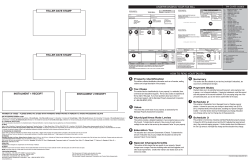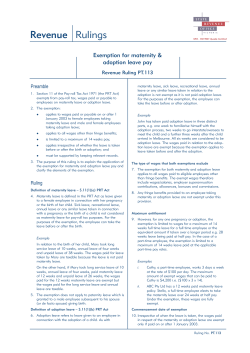
Ask the Court to Stop or Reduce a Bank Levy
Sacramento County Public Law Library & Civil Self Help Center 609 9th Street Sacramento, CA 95814 (916) 874-6012 www.saclaw.org Claim of Exemption: Bank Levy Ask the Court to Stop or Reduce a Bank Levy Disclaimer: This guide is intended as general information only. Your case may have factors requiring different procedures or forms. The information and instructions are provided for use in the Sacramento County Superior Court. Please keep in mind that each court may have different requirements. If you need further assistance, consult a lawyer. FORMS The Judicial Council forms commonly used in this procedure are: • Claim of Exemption (EJ-160) www.courts.ca.gov/documents/ej160.pdf • Financial Statement (EJ-165) www.courts.ca.gov/documents/ej165.pdf • Declaration (MC-030) www.courts.ca.gov/documents/mc030.pdf BACKGROUND A common method used by creditors to collect on court judgments is to levy bank accounts and safe deposit boxes held in the debtor’s name. To do this, the creditor must request that the court issue a Writ of Execution (EJ-130), which is a court order directing the sheriff of a particular county to enforce the judgment. With this Writ, the creditor may instruct the sheriff of the appropriate county to levy the accounts or safe deposit boxes in the debtor’s name at a particular bank. Upon receiving the order to levy from the Sherriff or registered process server, the bank will typically freeze the funds in the affected account(s) (up to the amount of levy), or will give those funds to the Sheriff. Only funds in the account at the time of the levy will be frozen or seized. If a judgment creditor attempts to levy your bank account, you will be mailed a Notice of Levy (EJ-150), along with some additional informational documents. The Sheriff will hold the seized funds for ten days, allowing you the opportunity to seek to stop or reduce the levy by filing a Claim of Exemption (EJ-160), which explains why you believe the seized money should be exempt. The court may order some or all of the funds an account exempt if: • The money in the account is from a source that is exempt by law, such as Social Security benefits; or • The money in the account is required for the basic necessities of life. Even if the court orders funds in the account exempt from collection, the judgment still exists, and will continue to accrue 10% simple interest each year. One of the documents that you should receive with your Notice of Levy (EJ-150) is Exemptions from the Enforcement of Judgments (EJ-155). This form lists the various asset types that may be exempt from collection. An adaptation of this document, with hyperlinks to the applicable code sections, is available on the Law Library’s website at www.saclaw.org/pages/exemptions.aspx. It is very important to read and understand the specific exemption(s) that may apply to you, because not all of these exemptions are complete (for example, employment wages are only 75% exempt), and some have limits on the amount of the exemption (for example, $2300 in a vehicle’s equity is exempt). IMPORTANT: Remember, once you receive these documents you have 10 days to file your Claim of Exemption (EJ-160) and Declaration (MC-030) with the Sheriff’s department listed on the Notice of Levy (EJ-150). Step-by-Step Instructions STEP 1: COMPLETE THE NECESSARY FORMS You may need to collect bank statements, paystubs, utility bills, etc., to assist you in completing these forms. Instructions for completing the necessary forms are included at the end of this packet. The forms commonly used in this procedure are: • Claim of Exemption (EJ-160) • Financial Statement (WG-007/EJ-165) (if you’re claiming the funds are necessary for the basic necessities of life) • Declaration (MC-030) STEP 2: COPYING AND ASSEMBLING Make three copies of each: • Claim of Exemption (EJ-160) • Financial Statement (WG-007/EJ-165) (if applicable) • Declaration (MC-030) If you are submitting a Financial Statement (WG-007/EJ-165), attach one copy to each copy of your Claim of Exemption (EJ-160). STEP 3: TURN IN YOUR PAPERS Take your completed documents to the Sheriff’s Department, as listed on the Notice of Levy (EJ-150). The Sheriff will mail one copy to the judgment creditor and keep the second. The third copy is for you to keep for your records. STEP 4: WHAT HAPPENS NEXT? The Sheriff or levying officer will hold the money or property until one of the following happens: The creditor agrees that the funds are exempt, or takes no action If the creditor does not oppose your claim of exemption within 10 days, it is automatically granted. The Sheriff or levying officer will return the money or property. 2 The creditor opposes your Claim If the creditor opposes your claim of exemption, you will receive a Notice of Opposition to Claim of Exemption (EJ-170) and Notice of Hearing on Claim of Exemption (EJ-175) that will set a court date for a judge to make a decision, probably within the month. If the judge agrees with your claim of exemption, you will get your money or property back. If the judge agrees with the creditor, the Sheriff or levying officer will send the money or property to the judgment creditor. The judge may also partially grant your claim, and will instruct the Sheriff or levying officer to return a portion of the money to you, and forward the remainder to the judgment creditor. Pursuant to Local Rule 1.06 (www.saccourt.ca.gov/local-rules/docs/chapter-01.pdf), the court will make a tentative ruling on your claim of exemption by 2:00 p.m. the court day before the hearing. You may read the tentative ruling online, or may call the Presiding Judge's department at 874-8142 to hear it. For more information, see the Sacramento County Superior Court’s website at www.saccourt.ca.gov/civil/motions-hearingstentative.aspx. Closely review the tentative ruling, because there will be a lot of important information included in it. Hopefully, you see that your claim of exemption is “GRANTED.” If this is the case, the tentative ruling will also order the Sheriff to return the funds to you. If your claim is “GRANTED in part,” the court will order that a portion of the funds be returned to you. If claim is “DENIED,” the funds will be released to the judgment creditor. You may also find that your hearing is “CONTINUED” to a future date. This is common if the court needs more information from you before making a ruling. Be sure to read the tentative ruling very carefully, because the court will specify what information or documents are required from you, and a date by which the information must be provided to the court. If you are happy with the tentative ruling, you do not need to do anything. You won’t have to go to court unless ordered to appear in the tentative ruling or unless the other side calls you and the court between 2:00 p.m. and 4:00 p.m. the court day before your hearing date to request an oral argument in front of the judge. If that happens, you should go to the court hearing and be prepared to argue your case. If you are not happy with the tentative ruling, and wish to present arguments in front of the judge, you must call all opposing counsel and/or self-represented parties, and the clerk for Department 53 ((916) 874-7858) or Department 54 ((916) 874-7848) no later than 4:00 p.m. the court day before your hearing and state that you are requesting oral argument on the motion. If neither you nor the opposing counsel or self-represented party requests oral argument, the court will simply make the tentative ruling the order of the court, and no oral argument will be permitted. IF YOU HAVE QUESTIONS ABOUT THIS GUIDE, OR IF YOU NEED HELP FINDING OR USING EN 3/2012 THE MATERIALS LISTED, DON’T HESITATE TO ASK A REFERENCE LIBRARIAN. H:\public\LRG-SBS\SbSs\SBS COE Bank Levy\SbS COE Bank Levy.docx 3 created 3/2012 en updated 3/2014 mpj Plaintiff = Judgment Creditor Defendant = Judgment Debtor as they appear in Notice of Levy Your name, address, and phone number. “In Pro Per” means you are representing yourself. Insert County, Name, and Address of the Sheriff’s Civil Dept. Insert Court County, Address, City, State, Zip, and Civil Division Sheriff’s Levy Number Mark these boxes as appropriate Case Number 4. Describe the property that is exempt. 5. Insert applicable code sections. 6. Insert “See attached Declaration.” If you are claiming that some, or all, of the amount levied should be withheld because it is necessary for the basic necessities of life, you will need to complete and attach a Financial Statement (WG-007/EJ-165). Complete paragraphs 7, 8, & 9 ONLY if they pertain to your situation. Print name and date Signature 4 If you are claiming that some, or all, of the amount levied should be withheld because it is necessary for the basic necessities of life, you will need to complete and attach a Financial Statement (WG-007/EJ-165). The Statement provides the court with a snapshot of your monthly income and expenses. If your only claim is that the funds are statutorily exempt, you do not need to complete this form. List each person in your household. If you have no spouse, write “none” on line a. Describe your monthly income. You may need several pay stubs to complete this section. Complete your asset information. Remember that “equity” is the fair value of the property minus the amount owed on it. If the total is negative, the equity is $0. 5 As a general rule, entertainment (line 4(l)) and most installment payments (line 4(j) and section 5) are not considered “basic necessities of life,” and such amounts will typically be ordered paid to the creditor. Exceptions are installments being paid to prior judgment debtors, installments being paid to the government for back taxes, or other debts that are legally entitled to priority over the judgment in this case. List your monthly expenses. If not paid monthly, estimate the amount if broken into monthly payments. If there are other facts to consider, list them here. Earnings withholdings or assignments (support payments) in effect as to your income or the income of a household member are listed in paragraphs 7 or 8. Check the appropriate box in paragraph 9. If the debtor is married, his or her spouse must sign unless the two are separated and living apart. 6 Your name, address, and phone number. “In Pro Per” means you are representing yourself. Plaintiff = Judgment Creditor Defendant = Judgment Debtor as they appear in Notice of Levy Insert Court information. Case Number Your declaration should provide a detailed description of why any funds are exempt from collection. You will also need to attach two or three months’ worth of bank statements to show the source of any money that goes into the bank account. The more sources of income, the more complicated the declaration will be in “tracing” the funds in the bank account. The amount of the funds that can be traced back to exempt sources (i.e. Social Security, SSI, etc.) will be exempt up to the amount allowed for each exemption. Keep in mind that this is being read by a sheriff, creditor, and possibly judge who has no prior knowledge of your circumstances, so be sure to explain things concisely and with sufficient detail. If you are attaching bank statements, be sure to “redact” (black out so they cannot be read) the account numbers, as this document might eventually end up filed with the court. If your Claim of Exemption is based on the necessities of life, it is possible to use a declaration to explain your household circumstances. Print name and date Sign and mark the “Defendant” box if you are the defendant, otherwise check the appropriate box. If no other box fits, check “Other” and write your title in this space. 7
© Copyright 2025





















